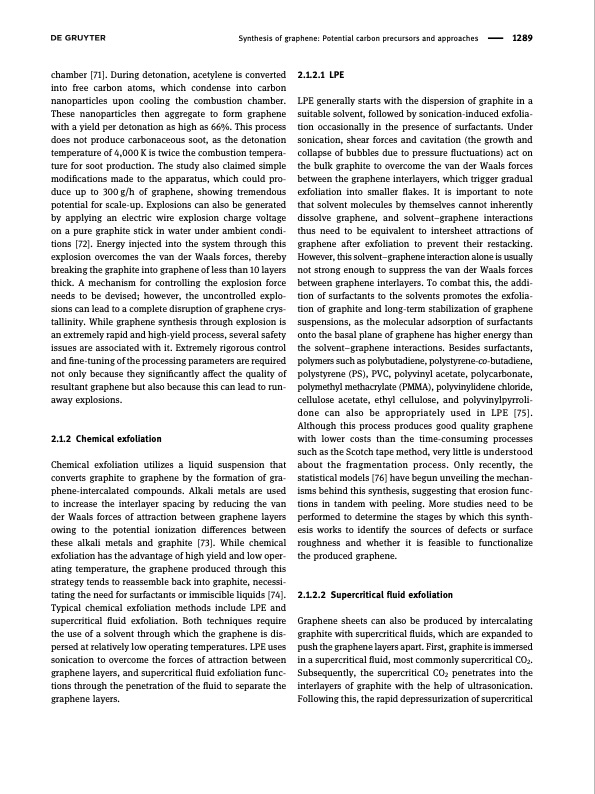
PDF Publication Title:
Text from PDF Page: 006
Synthesis of graphene: Potential carbon precursors and approaches 1289 chamber [71]. During detonation, acetylene is converted into free carbon atoms, which condense into carbon nanoparticles upon cooling the combustion chamber. These nanoparticles then aggregate to form graphene with a yield per detonation as high as 66%. This process does not produce carbonaceous soot, as the detonation temperature of 4,000 K is twice the combustion tempera- ture for soot production. The study also claimed simple modifications made to the apparatus, which could pro- duce up to 300 g/h of graphene, showing tremendous potential for scale-up. Explosions can also be generated by applying an electric wire explosion charge voltage on a pure graphite stick in water under ambient condi- tions [72]. Energy injected into the system through this explosion overcomes the van der Waals forces, thereby breaking the graphite into graphene of less than 10 layers thick. A mechanism for controlling the explosion force needs to be devised; however, the uncontrolled explo- sions can lead to a complete disruption of graphene crys- tallinity. While graphene synthesis through explosion is an extremely rapid and high-yield process, several safety issues are associated with it. Extremely rigorous control and fine-tuning of the processing parameters are required not only because they significantly affect the quality of resultant graphene but also because this can lead to run- away explosions. 2.1.2 Chemical exfoliation Chemical exfoliation utilizes a liquid suspension that converts graphite to graphene by the formation of gra- phene-intercalated compounds. Alkali metals are used to increase the interlayer spacing by reducing the van der Waals forces of attraction between graphene layers owing to the potential ionization differences between these alkali metals and graphite [73]. While chemical exfoliation has the advantage of high yield and low oper- ating temperature, the graphene produced through this strategy tends to reassemble back into graphite, necessi- tating the need for surfactants or immiscible liquids [74]. Typical chemical exfoliation methods include LPE and supercritical fluid exfoliation. Both techniques require the use of a solvent through which the graphene is dis- persed at relatively low operating temperatures. LPE uses sonication to overcome the forces of attraction between graphene layers, and supercritical fluid exfoliation func- tions through the penetration of the fluid to separate the graphene layers. 2.1.2.1 LPE LPE generally starts with the dispersion of graphite in a suitable solvent, followed by sonication-induced exfolia- tion occasionally in the presence of surfactants. Under sonication, shear forces and cavitation (the growth and collapse of bubbles due to pressure fluctuations) act on the bulk graphite to overcome the van der Waals forces between the graphene interlayers, which trigger gradual exfoliation into smaller flakes. It is important to note that solvent molecules by themselves cannot inherently dissolve graphene, and solvent–graphene interactions thus need to be equivalent to intersheet attractions of graphene after exfoliation to prevent their restacking. However, this solvent–graphene interaction alone is usually not strong enough to suppress the van der Waals forces between graphene interlayers. To combat this, the addi- tion of surfactants to the solvents promotes the exfolia- tion of graphite and long-term stabilization of graphene suspensions, as the molecular adsorption of surfactants onto the basal plane of graphene has higher energy than the solvent–graphene interactions. Besides surfactants, polymers such as polybutadiene, polystyrene-co-butadiene, polystyrene (PS), PVC, polyvinyl acetate, polycarbonate, polymethyl methacrylate (PMMA), polyvinylidene chloride, cellulose acetate, ethyl cellulose, and polyvinylpyrroli- done can also be appropriately used in LPE [75]. Although this process produces good quality graphene with lower costs than the time-consuming processes such as the Scotch tape method, very little is understood about the fragmentation process. Only recently, the statistical models [76] have begun unveiling the mechan- isms behind this synthesis, suggesting that erosion func- tions in tandem with peeling. More studies need to be performed to determine the stages by which this synth- esis works to identify the sources of defects or surface roughness and whether it is feasible to functionalize the produced graphene. 2.1.2.2 Supercritical fluid exfoliation Graphene sheets can also be produced by intercalating graphite with supercritical fluids, which are expanded to push the graphene layers apart. First, graphite is immersed in a supercritical fluid, most commonly supercritical CO2. Subsequently, the supercritical CO2 penetrates into the interlayers of graphite with the help of ultrasonication. Following this, the rapid depressurization of supercriticalPDF Image | Synthesis of graphene Potential carbon precursors

PDF Search Title:
Synthesis of graphene Potential carbon precursorsOriginal File Name Searched:
10-1515-ntrev-2020-0100.pdfDIY PDF Search: Google It | Yahoo | Bing
Salgenx Redox Flow Battery Technology: Power up your energy storage game with Salgenx Salt Water Battery. With its advanced technology, the flow battery provides reliable, scalable, and sustainable energy storage for utility-scale projects. Upgrade to a Salgenx flow battery today and take control of your energy future.
| CONTACT TEL: 608-238-6001 Email: greg@infinityturbine.com | RSS | AMP |